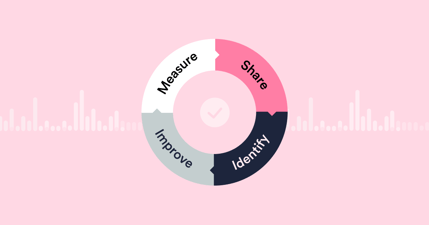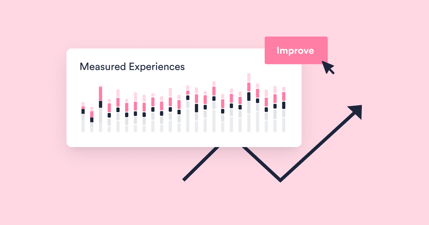If your IT organization has adopted ITIL best practices, it likely has time and financial resources earmarked for continual improvement activities. Even if it isn’t an “ITIL shop,” it still likely has scope to improve its operations and services. However, it might call it “continuous improvement.” The name isn’t important, though, unlike the desire to improve your IT operations and services (perhaps incrementally) based on what most needs improvement.
The key to success is understanding and agreeing on “what most needs improvement.” This is where IT experience data helps, showing not only which IT capabilities need improvement most but also what end-users deem to be the most important. It’s data-driven prioritization rather than what might currently happen in your organization—“gut-feel-driven prioritization.”
If experience-data-driven improvement sounds like a good approach for your IT organization, please keep reading to find out how best to drive continual improvement with IT experience data.
Continual improvement explained
ITIL 4 defines the purpose of its continual improvement practice as follows:
“…to align the organization’s practices and services with changing business needs through the ongoing improvement of products, services, and practices, or any element involved in the management of products and services.”
Source: PeopleCert, Continual Improvement ITIL 4 Practice Guide (2020)
However, few IT organizations have an unlimited time and budget for continual improvement, and they, therefore, need to prioritize the improvements that will make the most significant difference to business operations and outcomes.
Consider your IT organization’s continual improvement landscape
Your IT organization likely has many potential opportunities to improve, whether related to its operations, services, or experiences and outcomes. But which should it work on, and which should it “park” (at least for now)?
This is where experience data helps. However, the importance of experience data is two-fold – first, in the prioritization process, and second, in ensuring that any improvements result in the expected positive impact.
How IT experience data helps drive continual improvement
As already mentioned, while corporate continual improvement initiatives might have the best intentions, their focus is potentially driven by gut feelings rather than data. Plus, the data that is available to assist improvement decision-making likely relates to traditional IT metrics that focus on the “mechanics” of IT service delivery and support and only takes a supplier view of IT performance.
IT experience data, on the other hand, provides the end-user and business perspective needed to understand what matters most, enabling your IT organization to zero in on the improvements that are most needed to improve end-user experiences, productivity, and business outcomes.
But where should your organization start with experience-driven continual improvement?
First, set clear objectives
It might sound like a “no-brainer,” but trying to drive continual improvement efforts without focus will likely result in a “patchwork quilt” of small (and perhaps considered insignificant) benefits at best. So, decide your focus areas before planning to drive continual improvement using experience data.
Your experience data will help guide this, whether end-users and business leaders want your IT organization to increase employee satisfaction with IT services, reduce incident volumes, lower the mean time to resolution (MTTR), or something else. Ultimately, it’s important to focus on what matters most to business operations and outcomes, not what IT thinks is most important. Your business likely has little time or appetite for continual improvement initiatives that improve IT performance with little or no business-level value.
Understand what data is needed to drive continual improvement
This is not only the data to be collected but also the collection frequency. For example, we’re advocates for the continuous collection of human feedback that, thanks to integrations with corporate IT service management (ITSM) tools, can be understood in the context of the respective IT interactions.
Experience management models usually call out three types of data that collectively provide richer insight into IT performance:
- X-Data – Experience Data (how people feel)
- O-Data – Operational Data (what IT did)
- T-Data – Technical Data (how the technology worked).
This data is likely to reside in multiple systems, so there’s likely a need for you to centralize it in order to establish experience issues and trends and the root causes.
Don’t underestimate the required analysis effort
Some end-user issues might be obvious from the collected experience data. For example, issues with corporate IT self-service portals where the experience is reported as poor and the lost time as high. It just jumps out at you.
However, even when an issue is obvious, the root cause or causes might not be. This is where data analysis allows you to focus on areas such as:
- Patterns in support tickets or technical performance
- Differences across teams and regions
- The issues that affect the largest number of end-users
- Sudden and “unexplainable” dips in experience
- End-user issues that align with technical underperformance.
Be careful, though, as with the IT services consumed by the most end-users, volume doesn’t always equate to the most important. Sometimes, a “small” issue can have the biggest adverse business impact.
Prioritize improvements based on experience-aligned impact
This is where the proverbial “rubber hits the road.” Very few IT organizations can tackle every identified improvement opportunity. So, prioritization is needed to address those that will have the biggest positive impact on business operations and outcomes (in the context of affordability and “do-ability”).
Your continual improvement objectives will help here, but other factors might also come into play. For example, issue frequency and business impact. Prioritization can also consider the “time to value,” with quick-win opportunities providing a good balance for longer-term improvement initiatives.
But this is only the beginning
All of the above is merely getting to the point of making changes that bring about improvement. Of course, action needs to be taken to make the required changes.
Experience data helps here, too. It shows the impact of the changes as they are made. For example, are the “improvements” to a corporate application having the desired effect, no effect, or making experiences and productivity worse?
Without experience data, your continual improvement actions are like a rudderless ship – following the current without the ability to course-correct as needed. Experience data won’t necessarily prevent the initial issues but will allow for speedy identification and rectification.
If you want to learn more about driving continual improvement with experience data, you may find the following resources useful:




